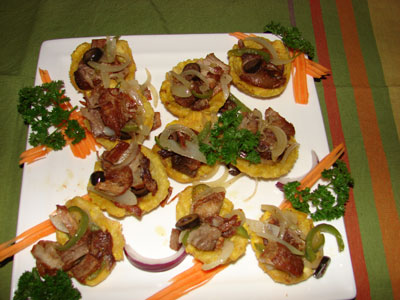What's Cooking in... Haiti
This item appears on page 54 of the July 2014 issue.
In the 1700s, Haiti was the glory of the French colonies and one of the richest colonies in the world. In 1804, Haiti, then known as Saint-Domingue, became an independent republic. Over the years, poor leadership and other issues caused economic troubles from which Haiti has never fully recovered, and the earthquake in 2010 only exacerbated the problems.
When my husband, John, and I visited Haiti in October 2013, we were impressed with the diversity of things to see and do. In all the places we visited, the people were hoping that an increase in tourism would lead to economic growth.
We visited the Citadel, a UNESCO World Heritage Site high on a mountain, and on the way up the mountain we stopped at the ruins of Sans-Souci Palace, a Versailles-like structure that was the royal residence of King Henry I. (Yes, there was once a king of Haiti.) It, too, is a World Heritage Site.
One of my favorite places was Jacmel, where there are not only nice beaches but shops with great local artwork that had been created out of whatever was handy. I was especially impressed with Charlotte, a shop that displayed colorful works of art made of gourds and reeds, near the Hotel Florita in central Jacmel on the Rue du Commerce.
High on a hill just outside of Jacmel, we were hosted by a lovely ecoresort, La Colline Enchantée (Coral Soult Marigot, Haiti; phone [509] 37 01 96 97 [website in French]), where rates for a double room range from $77 to $99 per night.
The owner, Michele Gehy, was very friendly and, like all the Haitians we met, proud of her country. While we were talking about Haitian food, she mentioned that plantains are the “Haitian potato.” I told her I had tried the Plantain Fritas and would love to know how to make them because they are not only delicious but would make great hors d’oeuvres.
She said, “Come with me and I will show you how to make them.”
We went into the kitchen, where she proceeded to show us, gratis, how to make Plantain Fritas. Part of the ingredients, the Griot de Porc, can be made ahead of time, refrigerated and then reheated when you’re ready to put it in the plantain cups to serve.
2 cups water
1 tsp salt
2 lemons
2 tbsp vegetable oil for frying or as needed
Juice of 2 limes
1 cup orange juice
1 green pepper, thinly sliced
4 to 6 cloves
5 cloves of garlic
¼ tsp thyme
¼ tsp salt
¼ tsp black pepper
2 onions, thinly sliced
Water as needed

